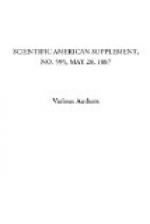During this time the stokehole hatches were open, but the fans were kept running at slow speed to maintain a moderate draught. The fuel used throughout the trip was briquettes made of the best Welsh anthracite worked up with a little tar. The briquettes were broken up to convenient sizes before being put in the bunkers. This fuel is not of so high evaporative efficiency as Nixon’s navigation coal, but it is more suitable for torpedo boat work, because it gives out Very little dust, while the coal in closed stokeholes half smothers the firemen. Watering only partially mitigates the evil. Besides this, the patent fuel does not clinker the tube ends—a matter of vital importance.
During the run down to Gravesend, the small quantity of smoke given out was borne down and away from the tops of the funnels by the fierce head wind, and now and then a heavy spray broke on the bows, wetting everything forward. In the engine room preparations were made for taking indicator diagrams. No attempt was made to drive the boat fast, because high speeds are prohibited by the river authorities on account of the heavy swell set up.
The measured mile on the Lower Hope is on the southern bank of the river, about three miles below Gravesend. Just as the boat passed the town, in the midst of a heavy rain squall, the stokehole hatches in the deck were shut, and the dull humming roar of the fans showed that the fires were being got up. The smoke no longer rose leisurely from the funnels. It came up now with a rush and violence which showed the powerful agency at work below. A rapid vibrating motion beneath the feet was the first evidence that the engines were away full speed. As the boat gathered way she seemed to settle down to her work, and the vibration almost ceased. The measured mile was soon reached, and then in the teeth of the northeaster she tore through the water. The tide and wind were both against her. Had the tide and wind been opposed, there would have been a heavy sea on. As it was, there was quite enough; the water, breaking on her port bow, came on board in sheets, sparkling in the sun, which, the rain squall having passed, shone out for the moment. As the wind was blowing at least thirty miles an hour, and the boat was going at some twenty-six miles an hour against it, the result was a moderate hurricane on board. It was next to impossible to stand up against the fury of the blast without holding on. The mile was traversed in less than 21/2 minutes, however; but the boat had to continue her course down the river for nearly another mile to avoid some barges which lay in the way, and prevented her from turning. Then the helm was put over, and she came round. There was no slacking of the engines, and astern of her the water leaped from her rudder in a great upheaved, foaming mass, some 7 ft. or 8 ft. high. Brought round, she once more lay her course. This time the wind was on her starboard quarter, or still more nearly




